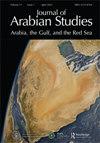Desert Dispute: The Diplomacy of Boundary-Making in South-Eastern Arabia
Q1 Social Sciences
引用次数: 1
Abstract
undertaken in pursuit of other objectives? Does protection against rival religious doctrines and practices work the same way as protection against physical harm and the destruction of homes and livelihoods? The latter probably necessitates the creation of a secure territory, but does the former do so as well? More important, is it useful to meld Tilly’s theory of generating threats and offering protection together with recent theories of securitization drawn from the discipline of international relations? One could set out to formulate an innovative analysis of the securitization process that incorporates the logic of the protection racket, but such an argument would stand sharply at odds with existing scholarship on the topic. It is to Ben Rich’s great credit that Securitising Identity inspires such scintillating reservations, whose resolution may enable future explorers to revise Tilly’s theory so that it can explain not only the eras of Saudi history for which we have the least information but also those that we think we know the best.沙漠之争:阿拉伯东南部边界划定的外交
是为了追求其他目标?对敌对宗教教义和实践的保护与对人身伤害和对家园和生计的破坏的保护是一样的吗?后者可能需要建立一个安全的领土,但前者也需要这样做吗?更重要的是,将蒂利关于制造威胁和提供保护的理论与最近从国际关系学科中得出的证券化理论结合起来是否有用?一个人可以着手对证券化过程进行创新分析,并将保护费的逻辑纳入其中,但这样的论点将与该主题的现有学术大相径庭。《身份证券化》激发了如此精彩的保留意见,这是本·里奇的伟大成就,它的解决方案可能使未来的探索者能够修改蒂利的理论,这样它不仅可以解释我们所知最少的沙特历史时期,还可以解释我们自认为最了解的沙特历史时期。
本文章由计算机程序翻译,如有差异,请以英文原文为准。
求助全文
约1分钟内获得全文
求助全文

 求助内容:
求助内容: 应助结果提醒方式:
应助结果提醒方式:


